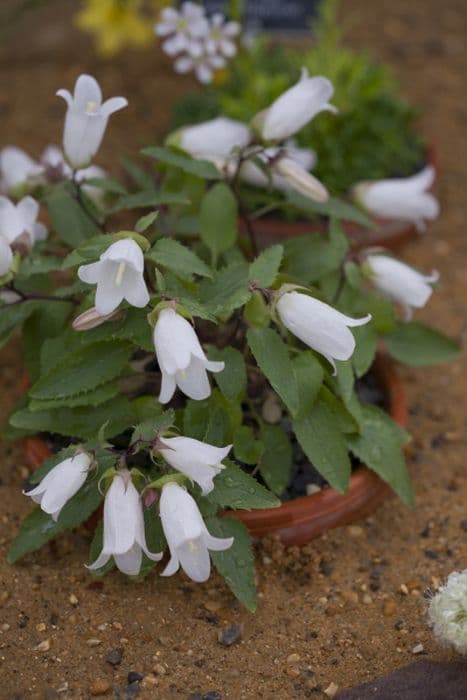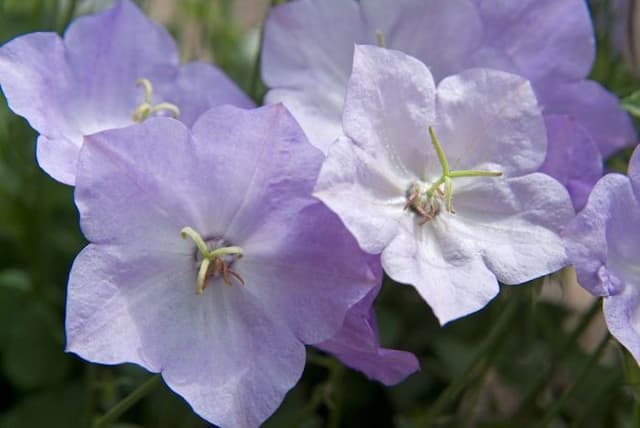Laguna Sky Blue Lobelia Lobelia Laguna Compact Blue With Eye = 'Lobetis' (PBR) (Laguna Series)

ABOUT
The Lobelia Laguna Compact Blue With Eye, part of the Laguna Series and often simply referred to as Lobelia 'Lobetis', is a stunning flowering plant known for its striking appearance. It features a mound of lush green foliage, which forms the backdrop for a profusion of vibrant blue flowers. Each bloom showcases a prominent eye that is often a contrasting or lighter color, adding to the visual interest of the plant. The flowers are delicate and trumpet-shaped, coming together in clusters to create a spectacular display of color and texture. The Lobelia 'Lobetis' is appreciated for its continuous blooming habit, producing flowers that can last throughout the growing season, making it a vivid and enduring addition to any garden display or arrangement.
About this plant
 Names
NamesFamily
Campanulaceae
Synonyms
Laguna Compact Blue With Eye Lobelia, Compact Blue With Eye Trailing Lobelia, 'Lobetis' Lobelia
Common names
Lobelia erinus 'Lobetis', Lobelia 'Lobetis'
 Toxicity
ToxicityTo humans
Lobelia is generally considered to have a low level of toxicity to humans. However, it contains alkaloids that can have toxic effects if ingested in large quantities. Symptoms of lobelia poisoning may include nausea, vomiting, diarrhea, cough, dizziness, excessive salivation, convulsions, and could potentially lead to a rapid heartbeat or hypotension. Ingesting any part of the plant, especially in large amounts, could lead to the aforementioned symptoms. It is advisable to handle lobelia with care and avoid ingesting it.
To pets
Lobelia is regarded as potentially toxic to pets, such as cats and dogs. The plant contains several alkaloids, which can cause poisoning if pets consume a significant amount. Symptoms of toxicity in pets may include vomiting, diarrhea, excessive drooling, or weakness. Serious cases may display more considerable signs like tremors, rapid heart rate, or hypotension. If a pet ingests any part of the lobelia plant, it is important to seek veterinary care promptly to manage the symptoms and prevent further complications.
 Characteristics
CharacteristicsLife cycle
Annuals
Foliage type
Deciduous
Color of leaves
Green
Flower color
Blue with eye
Height
0.5 feet (15 cm)
Spread
0.5 feet (15 cm)
Plant type
Herb
Hardiness zones
Varies
Native area
Not applicable
Benefits
 General Benefits
General Benefits- Attracts pollinators: The vibrant blue flowers of 'Lobetis' attract bees, butterflies, and other beneficial insects.
- Continuous Blooming: This plant offers a long flowering season, providing continuous color and interest from late spring to fall.
- Drought Tolerance: Once established, it has good tolerance to dry conditions, reducing the need for frequent watering.
- Easy to Grow: It is known for being low-maintenance and easy to care for, making it suitable for gardeners of all skill levels.
- Compact Growth Habit: The compact size makes it ideal for container gardening, small garden spaces, or as a border plant.
- Versatile Use: Suitable for hanging baskets, window boxes, and landscape beds, providing versatility in garden design and container planting.
- Cold Hardiness: It is relatively tolerant of cold temperatures and can survive in cooler climates within its suitable hardiness zones.
- Deer Resistance: The plant is not a preferred choice for deer, reducing the likelihood of damage in areas with deer populations.
 Medical Properties
Medical PropertiesThis plant is not used for medical purposes.
 Air-purifying Qualities
Air-purifying QualitiesThis plant is not specifically known for air purifying qualities.
 Other Uses
Other Uses- Artistic Inspirations: The vibrant colors of Lobelia can be used by artists and photographers as a subject for creating paintings, photographs or any artwork that features its unique color and structure.
- Natural Fabric Dyes: The pigments from Lobelia flowers may be used to create natural dyes for fabrics, adding a distinctive blue hue to textiles.
- Garden Themed Jewelry: The small, detailed flowers of the Lobelia can inspire handmade jewelry designs, such as pendants or earrings, capturing the essence of the garden.
- Fairy Gardens: Lobelia's compact size makes it perfect for planting in fairy gardens, providing a lush, blue background for miniature landscapes and fairy houses.
- Educational Tools: Lobelia plants can be used in schools or educational programs to teach children about botany and the growth requirements of different plant species.
- Floral Ice Cubes: Freeze small Lobelia flowers into ice cubes to create an elegant and unexpected touch to beverages at garden parties or weddings.
- Plant Photography Backdrops: The dense foliage and striking flowers of Lobelia are ideal for use as live backdrops in plant photography, especially for macro photography enthusiasts.
- Mood Enhancing Decor: Lobelia's bright and cheerful appearance can be used in interior design to create a fresh and uplifting mood in living spaces.
- Holiday Decorations: The deep blue flowers of Lobelia can be incorporated into festive wreaths or garlands for decorating during holidays or special occasions.
- Seed Harvesting: Gardeners can collect seeds from mature Lobelia plants to share or swap at local gardening clubs or events, fostering a community of plant enthusiasts.
Interesting Facts
 Feng Shui
Feng ShuiThe Lobelia is not used in Feng Shui practice.
 Zodiac Sign Compitability
Zodiac Sign CompitabilityThe Lobelia is not used in astrology practice.
 Plant Symbolism
Plant Symbolism- Devotion: Lobelia is often associated with devotion due to its perennial nature and the way it reliably blooms year after year.
- Communication: The bright blue color of Lobelia is believed to symbolize communication and expression, representing the sharing of thoughts and feelings.
- Healing: Traditionally, some species of Lobelia have been used in herbal medicine, which grants it symbolic meaning related to healing and well-being.
 Water
WaterLobelia Laguna requires regular watering to keep the soil evenly moist, especially during hot, dry periods. In general, watering thoroughly once or twice a week should suffice, but this can vary depending on climate conditions and soil type. It's best to check the top inch of soil for dryness before adding more water. Use approximately 16 ounces of water for smaller pots or up to 1 gallon for larger containers each time you water, adjusting as needed for your plant's size and environmental conditions.
 Light
LightLobelia Laguna thrives in full sun to partial shade exposure. It performs best when it receives at least 4 to 6 hours of sunlight daily, but can benefit from some afternoon shade in regions with very intense sun. An ideal spot is one where it can bask in the morning sunlight, which is less harsh than the afternoon rays.
 Temperature
TemperatureLobelia Laguna prefers moderate temperatures and can generally tolerate a range from 50 to 80 degrees Fahrenheit. The ideal temperature for robust growth and flowering is between 60 and 70 degrees Fahrenheit. Be cautious of exposure to temperatures below 50 degrees and above 80 degrees, as these can stress the plant and impact its health and flowering.
 Pruning
PruningRegular deadheading of spent blooms on Lobelia Laguna encourages further flowering and maintains the plant's neat appearance. Prune lightly throughout the blooming season to remove withered flowers. A more thorough pruning can be done in early spring to rejuvenate the plant, promoting fresh growth and fuller habit.
 Cleaning
CleaningAs needed
 Soil
SoilLobelia (Lobelia erinus) thrives best in moist, well-draining soil with a rich organic content. A good soil mix would be equal parts of peat, loam, and perlite or sand for drainage. The pH should be slightly acidic to neutral, ranging from 6.0 to 7.0.
 Repotting
RepottingLobelias do not generally require frequent repotting and can often be left undisturbed for several years. Consider repotting every 2-3 years or if the plant becomes root-bound.
 Humidity & Misting
Humidity & MistingLobelias prefer moderate to high humidity levels; however, they are quite adaptable and can tolerate average household humidity.
 Suitable locations
Suitable locationsIndoor
Ensure bright indirect light and maintain moisture.
Outdoor
Plant in partial shade and water regularly.
Hardiness zone
10-11 USDA
 Life cycle
Life cycleThe Lobelia 'Lobetis' (PBR) (Laguna Series), commonly referred to as Laguna Compact Blue With Eye, starts its lifecycle when the seeds are sown in a well-drained growing medium, ideally during late winter. Following germination, seedlings emerge and grow, benefiting from consistent moisture and light. As the plants mature, they develop a compact, bushy habit, adorned with striking blue flowers with eye-catching central white 'eyes' that bloom from late spring through to the first frosts of autumn. This perennial plant may die back during colder months, entering a dormancy phase where underground parts survive to regrow in spring. In climates where winters are milder, Lobelia 'Lobetis' may persist as an evergreen, requiring minimal care to prepare for the next cycle of growth and blooming. Properly cared for, these plants can last several years, going through repeated cycles of growth, flowering, and dormancy.
 Propogation
PropogationPropogation time
Spring-Early Summer
The most popular method of propagating Lobelia Laguna Compact Blue With Eye, commonly known as Lobelia, is through seed sowing. This should be done in late winter or early spring to allow for a full growing season. The tiny seeds should be sprinkled on the surface of a well-drained seed-starting mix and kept moist. They require light to germinate, so they should not be covered with soil. Placing the seed tray in a warm spot at approximately 72 degrees Fahrenheit (22 degrees Celsius) can enhance germination. Once seedlings have developed a couple of true leaves and are large enough to handle, they can be transplanted into individual pots and later moved to their final location outdoors after the risk of frost has passed.









